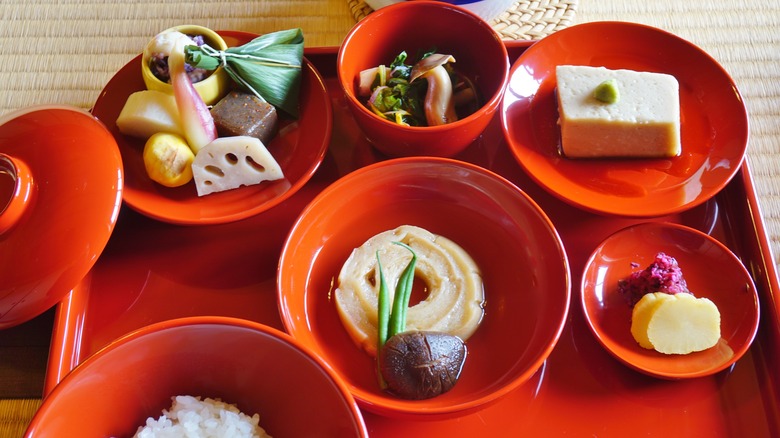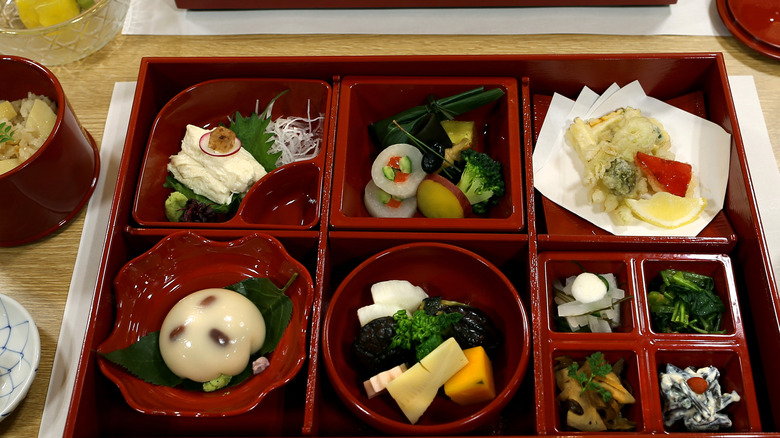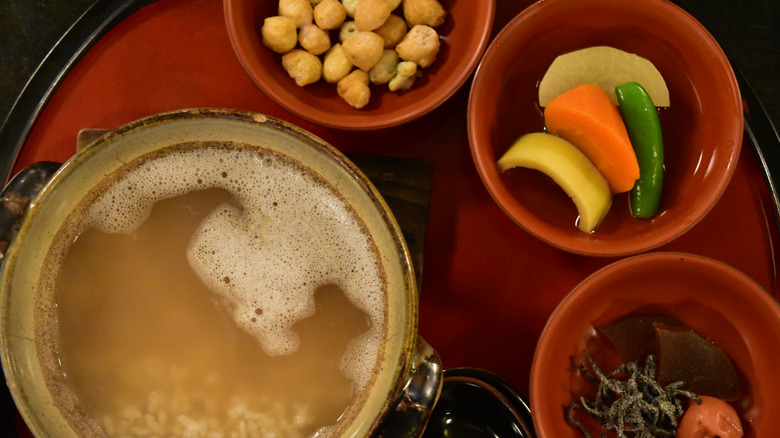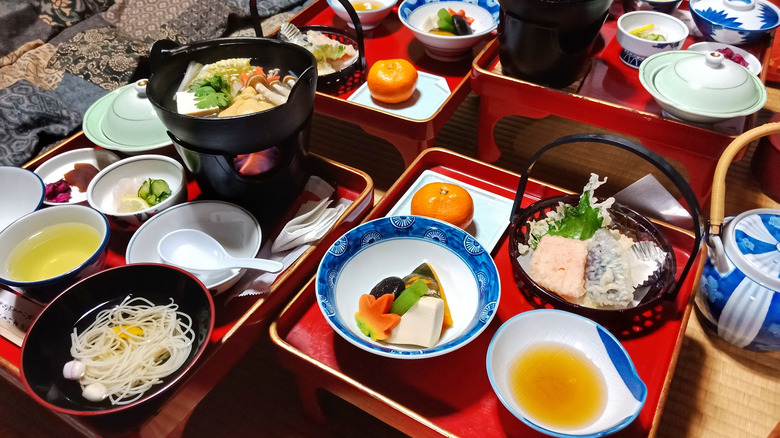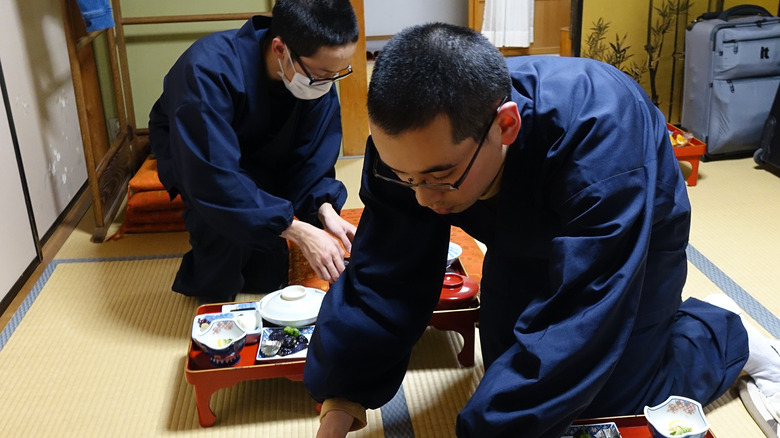The Buddhist Origins Of The Shojin Ryori Diet
If you're looking to simplify your diet or want to bring more mindfulness into your meals, get ready to take a page or two from the book of Shojin Ryori. Originally affiliated with Buddhist philosophy, Shojin Ryori is a plant-based cuisine that can be found at temples and restaurants throughout Japan. Matcha explains that traditional Shojin Ryori meals were part of Buddhist monks' training, a mindfulness practice that emphasized the importance of eating only what is needed for survival — and not for enjoyment or taste.
Shojin Ryori literally means "devotion food," according to All About Japan, and chefs and practitioners gather and prepare ingredients in line with Buddhist philosophy. Part of the beauty of Shojin Ryori is in its simplicity, notes By Food. But it takes time to make dishes accordingly, warns the Japanese-English Bilingual Corpus of Wikipedia's Kyoto Articles, as careful consideration is taken to assemble and present each dish.
History of Shojin Ryori
The teachings of Buddhism helped spread the philosophy associated with Shojin Ryori throughout Japan, explains Hachinoki. According to Yabai, its popularity grew along with the practices of 13th-century Zen Buddhism and was encouraged by the founder of Zen Buddhism, a monk named Dōgen. Dōgen connected spiritual practice with food, notes Kokoro Cares, and many of the elements involved with Shojin Ryori cuisine differed from some of the Japanese food trends at the time. Since monks weren't allowed to eat either meat or fish, explains Matcha, and alcohol and strong vegetables like garlic and onion were to be avoided (these rules relaxed over time), the Shojin Ryori way of eating echoed these practices.
Go With Guide explains that "shojin" references both the quest for enlightenment and the goal of detaching from worldly thoughts; accordingly, Shojin Ryori meals are prepared with these aims in mind. Balance and harmony are the focus, and ingredients and flavors are selected with intention.
Preparing Shojin Ryori
The Shojin Ryori way of preparing food, the taste of the meals, and the presentation of the dishes are intended to emphasize harmony and equilibrium, notes Kokoro Cares; this practice stems from the Buddhist belief that a person's body and mind are linked with the environment. The point is freshness, and choosing seasonal foods helps connect diners to the world around them. From choosing ingredients to eating the dishes, mindfulness is a key component of this style of eating, instructs Tofu Gu. Even the importance of reducing waste is emphasized while preparing Shojin Ryori cuisine, according to Yabai; instead of throwing away carrot peels, for instance, such discard would be used to make soup.
Chefs preparing Shojin Ryori meals strive to include red, green, white, black, and yellow elements, describes All About Japan, as this Japanese "food pyramid" was thought to provide optimal nutrition while also incorporating a variety of fresh, seasonal vegetables and tastes. The other aim is to include the five different tastes: sweet, salty, sour, bitter, and umami into each meal. Kokoro Cares adds the five cooking techniques — simmer, fire, grill, steam, and raw — are also considered when preparing dishes.
Shojin Ryori ingredients and dishes
Shojin Ryori meals typically include a seasonal soup accompanied by three side dishes and servings of rice and pickles, per Yabai. Sesame oil, soy sauce, mirin, and miso are used in moderation to flavor dishes, notes Arigato Japan, and dashi is a key ingredient — but instead of fish products typically found in Japanese cuisine, the dashi prepared for Shojin Ryori is made with vegetables like dried kelp or mushroom. This swapping of meat and fish with vegetable substitutes is known as modoki ryori, explains By Food.
Shojin Ryori meals are anything but tasteless, Yabai assures, as the dishes are made from carefully prepared ingredients. Seasonal vegetables, nuts, and soybeans are key components of menus, as fresh produce not only represents the cycles of nature but is believed to benefit the body. Cooling tomatoes and eggplants are found in summer dishes and pumpkins and sweet potatoes are used in fall meals to provide energy. Daikon radish is a common ingredient found in soups, as a garnish, or pickled, as the radish is nutritious, affordable, and versatile.
While side dishes vary throughout the year, goma-dofu, a dish made with tofu, sesame paste, and wasabi, is often included; Arigato Japan describes this dish as simple-looking but notes it takes time to prepare correctly.
Where to find Shojin Ryori
Shojin Ryori gave way to various spinoffs, notes Japanese-English Bilingual Corpus of Wikipedia's Kyoto Articles, with meals still thoughtfully presented, but brighter, less traditional, and intended to appeal to commoners, intellectuals, and artists — regardless of Buddhist practices.
Today in Japan, temples continue to offer Shojin Ryori cuisine not only to Buddhist practitioners but also to those interested in experiencing and learning about this unique aspect of Buddhist teaching. Restaurants serve Shojin Ryori meals, though not necessarily in the traditional way, notes Yabai. Additionally, while Shojin Ryori meals didn't historically contain milk or egg products, modern Shojin Ryori cuisine — especially those offered in restaurants — may include dairy or egg-based ingredients.
Some restaurants in Tokyo that focus on preserving Shojin Ryori have been awarded Michelin stars, notes Kokoro Cares. For instance, at Tokyo's Daigo, Shojin Ryori is served with a contemporary twist, and katsuobushi — a tuna product — is used to flavor the dashi (per Michelin Guide).
While you can try to produce your own version of Shojin Ryori at home, simply inviting more mindfulness into food prep will bring positive feelings of creativity and well-being into your kitchen.
